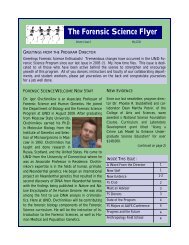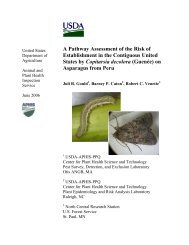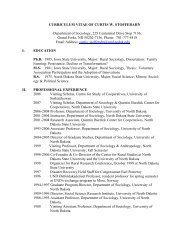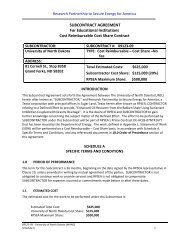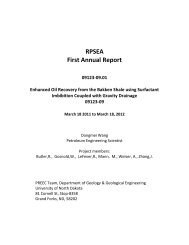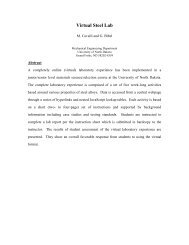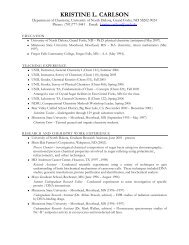Dirigent proteins in conifer defense: gene discovery, phylogeny, and ...
Dirigent proteins in conifer defense: gene discovery, phylogeny, and ...
Dirigent proteins in conifer defense: gene discovery, phylogeny, and ...
You also want an ePaper? Increase the reach of your titles
YUMPU automatically turns print PDFs into web optimized ePapers that Google loves.
30<br />
Table 3. Sequence relatedness of spruce DIR <strong>and</strong> DIR-like <strong>prote<strong>in</strong>s</strong>. a<br />
a b c d e f g h i j k l m n o p q r s<br />
PDIR3 (a) 100<br />
PDIR7 (b) 98 100<br />
PDIR1 (c) 90 91 100<br />
PDIR10 (d) 83 84 87 100<br />
PDIR9 (e) 74 75 73 74 100<br />
PDIR14 (f) 82 83 80 80 80 100<br />
PDIR11 (g) 75 76 76 75 74 78 100<br />
PDIR4 (h) 74 75 73 75 74 78 80 100<br />
PDIR12 (i) 78 77 77 81 71 76 72 70 100<br />
PDIR17 (j) 52 52 51 53 49 53 50 50 52 100<br />
PDIR2 (k) 26 26 24 24 23 26 23 23 25 26 100<br />
PDIR6 (l) 26 26 24 23 23 26 24 23 24 23 91 100<br />
PDIR8 (m) 26 26 24 23 23 24 23 23 24 25 88 86 100<br />
PDIR16 (n) 26 26 24 24 23 25 23 23 24 25 89 88 93 100<br />
PDIR13 (o) 27 27 25 25 24 27 25 25 25 25 87 86 85 86 100<br />
PDIR5 (p) 24 24 22 21 23 24 21 22 23 24 85 84 81 81 81 100<br />
PDIR15 (q) 24 24 22 21 21 22 21 21 22 22 85 84 82 81 81 96 100<br />
PDIR18 (r) 21 21 19 20 20 21 19 20 20 22 67 65 65 65 65 66 65 100<br />
PDIR19 (s) 23 23 22 22 21 24 22 23 23 24 68 67 66 67 68 67 66 61 100<br />
a Results from pairwise am<strong>in</strong>o acid sequence comparisons are shown as percent identity among members of the DIR-a subfamily<br />
(italics), the DIR-b subfamily (bold) <strong>and</strong> between DIR-a <strong>and</strong> DIR-b subfamily members (regular).<br />
the DIR-a subfamily cloned from Forsythia <strong>in</strong>termedia<br />
(Dav<strong>in</strong> et al., 1997), Podophyllum peltatum<br />
(Xia et al., 2000), <strong>and</strong> western red cedar (Kim et al.,<br />
2002). S<strong>in</strong>ce biochemical functions for members of<br />
subfamilies DIR-b, DIR-c, DIR-d <strong>and</strong> DIR-e are<br />
not known we refer to these <strong>gene</strong>s as DIR-like. It is<br />
important to note that overall sequence identity<br />
between <strong>and</strong> with<strong>in</strong> subfamilies is <strong>in</strong> some cases very<br />
low, which could expla<strong>in</strong> why a relatedness of<br />
known DIR <strong>prote<strong>in</strong>s</strong> (DIR-a) with the DIR-like<br />
<strong>prote<strong>in</strong>s</strong> was not previously recognized. However,<br />
when a m<strong>in</strong>imum of 50% am<strong>in</strong>o acid identity is<br />
applied as a criterion to identify conserved motifs<br />
common to all 72 plant DIR or DIR-like <strong>prote<strong>in</strong>s</strong> <strong>in</strong><br />
our analysis we found the follow<strong>in</strong>g motifs (Figure<br />
1) characteristic of this extended DIR- <strong>and</strong><br />
DIR-like prote<strong>in</strong> family: motif I, LsLYFHDaahG<br />
beg<strong>in</strong>n<strong>in</strong>g at am<strong>in</strong>o acid 43 (all positions relative to<br />
PDIR1); motif II, FGsasVhDDPaT beg<strong>in</strong>n<strong>in</strong>g at<br />
am<strong>in</strong>o acid 74; motif III, SssVGRAQGhY beg<strong>in</strong>n<strong>in</strong>g<br />
at am<strong>in</strong>o acid 92; motif IV, uTashsG beg<strong>in</strong>n<strong>in</strong>g<br />
at am<strong>in</strong>o acid 128; <strong>and</strong> motif V, RcaS<br />
VVGGTGcFhMARGaAsacT beg<strong>in</strong>n<strong>in</strong>g at am<strong>in</strong>o<br />
acid 143; where h = hydrophobic, p = polar,<br />
a = aliphatic, s = small, u = t<strong>in</strong>y, c = charged<br />
<strong>and</strong> x = any. These motifs clearly connect DIR <strong>and</strong><br />
DIR-like <strong>prote<strong>in</strong>s</strong>, <strong>and</strong> justify a broader view of this<br />
family <strong>and</strong> its sequence diversity.<br />
N<strong>in</strong>e of the 19 spruce DIR <strong>gene</strong>s group <strong>in</strong>to<br />
subfamily DIR-a (Figure 2), along with all other<br />
known gymnosperm DIR sequences, <strong>and</strong> a collection<br />
of 11 DIR <strong>gene</strong>s from several angiosperm<br />
monocot <strong>and</strong> dicot species. With<strong>in</strong> subfamily DIRa<br />
predicted ORFs range from 182 (AtDIR5) to 224<br />
(PDIR18) am<strong>in</strong>o acids (Figure 1), <strong>and</strong> am<strong>in</strong>o acid<br />
identity ranges from 12.3% to 99.5%. The DIR-a<br />
cluster of six rice (Oryza sativa) <strong>and</strong> Arabidopsis<br />
<strong>prote<strong>in</strong>s</strong> is notably divergent from the other DIR-a<br />
members. When only the conserved portion of the<br />
prote<strong>in</strong> sequence (ca. 160 am<strong>in</strong>o acids) used for the<br />
<strong>phylogeny</strong> analysis is exam<strong>in</strong>ed, am<strong>in</strong>o acid identity<br />
ranges from 36.2% to 99.4%. The spruce DIR<br />
am<strong>in</strong>o acid identity across the entire prote<strong>in</strong> length<br />
ranges from 61.2% to 96.4%, with predicted ORFs<br />
rang<strong>in</strong>g from 195 (PDIR2, PDIR6 <strong>and</strong> PDIR13) to<br />
224 (PDIR18) am<strong>in</strong>o acids. The rema<strong>in</strong><strong>in</strong>g 10<br />
spruce DIR-like <strong>gene</strong>s group <strong>in</strong>to subfamily<br />
DIR-b, along with 9 DIR <strong>gene</strong>s from several<br />
angiosperm monocot <strong>and</strong> dicot species. Despite<br />
previous work with DIR <strong>gene</strong>s from western red<br />
cedar <strong>and</strong> western hemlock, no gymnosperm<br />
sequences of the DIR-b group have previously<br />
been reported. With<strong>in</strong> subfamily DIR-b am<strong>in</strong>o<br />
acid identity is extremely divergent, rang<strong>in</strong>g from<br />
9.5% to 98.9%, with very little conservation with<strong>in</strong><br />
the N-term<strong>in</strong>al half of <strong>prote<strong>in</strong>s</strong>. When only the






